Distributed Approach to Satellite Direct-to-Cell Connectivity in 6G Non-Terrestrial Networks
IF 10.9
1区 计算机科学
Q1 COMPUTER SCIENCE, HARDWARE & ARCHITECTURE
引用次数: 0
Abstract
Satellite direct-to-cell (D2C) connectivity considers the communication between satellites and low-cost handheld devices on Earth. It represents one of the most challenging aspects of the integration between terrestrial and non-terrestrial networks. Low Earth orbit (LEO), sub-6GHz bands, and large aperture satellite antennas are the key to enable D2C connectivity. The industry is tackling the problem with a conventional approach, consisting of the design of very large reflectors or phased arrays. This article proposes a new way to face the problem: the distributed approach. A satellite base station (BS) is decomposed into several small platforms in a so-called swarm configuration to form a sparse phased array. The use of small satellites promises cost-effective solutions, while distributed satellite systems (DSSs) increase the fault tolerance, and thus the reliability, of the entire constellation. This article compares the performance of conventional and distributed approaches under different conditions. It shows that distributed approaches outperform conventional ones even under unfavorable conditions and pessimistic assumptions. Important tradeoffs are derived showing the flexibility of distributed approaches. Finally, major research aspects for exploiting the full potential of the distributed approach are highlighted.6G 非地面网络中卫星直达蜂窝连接的分布式方法
卫星直接到小区(D2C)连接考虑卫星和地球上低成本手持设备之间的通信。它代表了地面和非地面网络之间整合的最具挑战性的方面之一。低地球轨道(LEO)、6ghz以下频段和大口径卫星天线是实现D2C连接的关键。业界正在用传统的方法解决这个问题,包括设计非常大的反射器或相控阵。本文提出了一种新的方法来解决这个问题:分布式方法。卫星基站(BS)被分解成几个小平台,形成所谓的群配置,以形成稀疏相控阵。小卫星的使用保证了成本效益的解决方案,而分布式卫星系统(DSSs)增加了整个星座的容错性,从而提高了可靠性。本文比较了传统方法和分布式方法在不同条件下的性能。结果表明,即使在不利条件和悲观假设下,分布式方法也优于传统方法。得出了重要的权衡,显示了分布式方法的灵活性。最后,强调了开发分布式方法的全部潜力的主要研究方面。
本文章由计算机程序翻译,如有差异,请以英文原文为准。
求助全文
约1分钟内获得全文
求助全文
来源期刊

IEEE Wireless Communications
工程技术-电信学
CiteScore
24.20
自引率
1.60%
发文量
183
审稿时长
6-12 weeks
期刊介绍:
IEEE Wireless Communications is tailored for professionals within the communications and networking communities. It addresses technical and policy issues associated with personalized, location-independent communications across various media and protocol layers. Encompassing both wired and wireless communications, the magazine explores the intersection of computing, the mobility of individuals, communicating devices, and personalized services.
Every issue of this interdisciplinary publication presents high-quality articles delving into the revolutionary technological advances in personal, location-independent communications, and computing. IEEE Wireless Communications provides an insightful platform for individuals engaged in these dynamic fields, offering in-depth coverage of significant developments in the realm of communication technology.
 求助内容:
求助内容: 应助结果提醒方式:
应助结果提醒方式:


